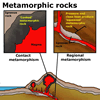Note: All pictures are meant as guides only, as often the difference between one metamorphic rock type and another is only in the size of the mineral grains.
Metamorphosis is the name of the process a caterpillar undergoes as it changes to a butterfly. Similarly, metamorphism is a part of the rock cycle that occurs when rocks deeply buried in the Earth are heated and compressed sufficiently to change the properties of the rocks, making them harder and more coherent and forming new minerals. When rocks undergo this type of change, they are called metamorphic rocks.
Metamorphic changes can be brought about by a combination of heat and high pressure, as is present deep inside the Earth, or may also occur with high temperatures alone, such as in rocks adjacent to lava intrusions. The different types of metamorphic rock formed are determined by temperate, pressure and the composition of the original rock.
Contact
Metamorphism
 Contact metamorphism occurs in rocks as a result of rock being in close
contact with extremely hot molten rock in igneous intrusions. The most
common examples of contact metamorphic rocks are marble, which is formed
from metamorphism of limestone, and quartzite, which is derived from sandstone.
These rocks are characterised by a uniform grain size and no evidence
of foliation or layering of minerals.
Contact metamorphism occurs in rocks as a result of rock being in close
contact with extremely hot molten rock in igneous intrusions. The most
common examples of contact metamorphic rocks are marble, which is formed
from metamorphism of limestone, and quartzite, which is derived from sandstone.
These rocks are characterised by a uniform grain size and no evidence
of foliation or layering of minerals.
 Regional
Metamorphism
Regional
Metamorphism
Rocks buried deep inside the Earth are exposed
to high temperatures and pressures over vast areas. Minerals recrystallise
and often change into a layered structure as a result of the extreme pressure.
 Very
fine-grained and layered sedimentary rocks (such as mudstones and shales)
exposed to such conditions will form a strongly layered rock called slate,
used extensively in the building industry. In slate, the recrystallisation
process has only just commenced and the metamorphism is termed low grade.
The lowest grade slate is often difficult to distinguish from sedimentary
rocks. The layering occurs because the mineral formed in the recrystallisation
is a flat mineral called mica.
Very
fine-grained and layered sedimentary rocks (such as mudstones and shales)
exposed to such conditions will form a strongly layered rock called slate,
used extensively in the building industry. In slate, the recrystallisation
process has only just commenced and the metamorphism is termed low grade.
The lowest grade slate is often difficult to distinguish from sedimentary
rocks. The layering occurs because the mineral formed in the recrystallisation
is a flat mineral called mica.

 Further
increases in temperature and pressure will lead to higher-grade metamorphic
rocks as recrystallisation becomes more substantial and grains become
visible to the naked eye. In order, this may produce phyllite, schist,
and ultimately the very high-grade gneiss, which is characterised by a
black and white banded texture.
Further
increases in temperature and pressure will lead to higher-grade metamorphic
rocks as recrystallisation becomes more substantial and grains become
visible to the naked eye. In order, this may produce phyllite, schist,
and ultimately the very high-grade gneiss, which is characterised by a
black and white banded texture.
If rocks undergoing metamorphism become too hot, they may actually melt and would then be classified as igneous when they solidify.
| Copyright owned by the State of Victoria (Department of Education and Early Childhood Development). Used with Permission. |
|
|||||||||||||||||||||||